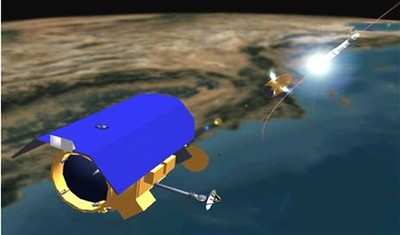Sat, Aug 25, 2007
Exercise to Help Understanding of Missile Exhaust Plumes
Lt. Gen. Henry "Trey" Obering III, Missile Defense Agency
director, announced Thursday the successful execution of an
exercise designed to collect data on a boosting long-range target
missile by the Near Field Infrared Experiment (NFIRE) research
satellite.

A modified Minuteman II booster vehicle was launched from
Vandenberg Air Force Base in CA. It was successfully tracked by the
NFIRE satellite. The NFIRE satellite has been in orbit since it was
launched from the National Aeronautics and Space Administration's
Wallops Island, VA, space launch facility on April 24, 2007, said
the agency.
This exercise was an opportunity for the NFIRE satellite to
collect high and low resolution images of a boosting rocket which
will improve understanding of missile exhaust plume observations
and plume-to-rocket body discrimination. Data from the NFIRE
satellite was downlinked to the Missile Defense Space
Experimentation Center (MDSEC) at the Missile Defense Integration
& Operations Center (MDIOC) at
Schriever AFB, CO.
The NFIRE exercise campaign supports the design and development
of space-based sensors like the Space Tracking and Surveillance
System (STSS) currently under development as well as design and
development of boost phase interceptor sensors.
Program officials will continue to evaluate system performance
based upon telemetry and other data obtained during the
exercise.
The Missile Defense Agency will use this data to validate and
update models and simulations fundamental to missile defense
technologies.
General Dynamics designed and manufactured the satellite and is
the system integrator for the NFIRE mission. The Air Force Research
Laboratory (AFRL) and Science Applications International Corp.
provided the primary payload, the Track Sensor Payload, and Orbital
Sciences Corp. provided the booster rocket system.
The secondary payload for conducting crosslink
satellite-to-satellite and satellite-to-ground communication
experiments is the Laser Communication Terminal built by
Tesat-Spacecom of Germany.
More News
Aero Linx: Model Aeronautical Association of Australia MAAA clubs are about fun flying, camaraderie and community. For over 75 years, the MAAA has been Australia’s largest fl>[...]
Touchdown Zone Lighting Two rows of transverse light bars located symmetrically about the runway centerline normally at 100 foot intervals. The basic system extends 3,000 feet alon>[...]
“Discovery and innovation are central to our mission at Virgin Galactic. We’re excited to build on our successful record of facilitating scientific experiments in subor>[...]
How To Get A Story On Aero-TV News/Feature Programming How do I submit a story idea or lead to Aero-TV? If you would like to submit a story idea or lead, please contact Jim Campbel>[...]
Student Pilot Reported That During Rotation, “All Of A Sudden The Back Of The Plane Kicked To The Right..." Analysis: The student pilot reported that during rotation, “>[...]
 ANN's Daily Aero-Linx (05.02.24)
ANN's Daily Aero-Linx (05.02.24) ANN's Daily Aero-Term (05.02.24): Touchdown Zone Lighting
ANN's Daily Aero-Term (05.02.24): Touchdown Zone Lighting Aero-News: Quote of the Day (05.02.24)
Aero-News: Quote of the Day (05.02.24) ANN FAQ: Contributing To Aero-TV
ANN FAQ: Contributing To Aero-TV NTSB Final Report: Cirrus Design Corp SR20
NTSB Final Report: Cirrus Design Corp SR20



